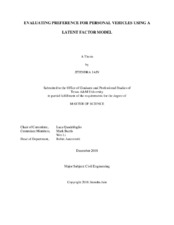| dc.contributor.advisor | Quadrifoglio, Luca | |
| dc.creator | Jain, Jitendra | |
| dc.date.accessioned | 2019-01-23T20:40:40Z | |
| dc.date.available | 2020-12-01T07:33:37Z | |
| dc.date.created | 2018-12 | |
| dc.date.issued | 2018-10-31 | |
| dc.date.submitted | December 2018 | |
| dc.identifier.uri | https://hdl.handle.net/1969.1/174515 | |
| dc.description.abstract | Automobiles have brought rapid changes in transportation with people from different areas and backgrounds jointly contributing to its diversity and complexity. This has given rise to unique needs and behaviors when it comes to making travel decisions. As such, there is a need to study these characteristics and plan for a more efficient and robust transportation system in the future. In this research, Factor analysis and Structural Equations Modeling (SEM) were used to derive hypothesized causal relationship of car mode choice with identified and selected variables of livability, alternative modes of transportation and socio-demographic data from a National level postal survey for sampled adults. It consisted of a literature review on factors associated with travel behavior in past studies and incorporated an exploratory and confirmatory analysis for a more comprehensive SEM model.
The results from the analysis indicated that an increase in the importance of alternative modes of transportation or an improvement in the quality of Recreation and Services would reduce the preference for cars in daily trips when there are no moderating effects. A multi-group analysis revealed that an increase in the quality of Recreation and Services would lead to a decreased preference for automobiles in transit available areas whereas it would increase for transit non-available areas. Also, older people would prefer more automobiles in the presence of transit and lesser in the absence of it. While working status had no effect on the nature of the relationships, it did influence working and non-working people differently. This study offers analytical evidence for debating the role of community livability on influencing driving as the travel mode. It also provided a structure of inter-relationships among the variables and the latent underlying constructs which presents a framework for any future improvement strategy. | en |
| dc.format.mimetype | application/pdf | |
| dc.language.iso | en | |
| dc.subject | Structural Equation Modeling | en |
| dc.subject | Livability | en |
| dc.subject | Car choice | en |
| dc.subject | Travel Behavior | en |
| dc.subject | Latent Factor | en |
| dc.title | Evaluating Preference for Personal Vehicles Using a Latent Factor Model | en |
| dc.type | Thesis | en |
| thesis.degree.department | Civil Engineering | en |
| thesis.degree.discipline | Civil Engineering | en |
| thesis.degree.grantor | Texas A & M University | en |
| thesis.degree.name | Master of Science | en |
| thesis.degree.level | Masters | en |
| dc.contributor.committeeMember | Burris, Mark | |
| dc.contributor.committeeMember | Li, Wei | |
| dc.type.material | text | en |
| dc.date.updated | 2019-01-23T20:40:41Z | |
| local.embargo.terms | 2020-12-01 | |
| local.etdauthor.orcid | 0000-0003-2685-5210 | |


